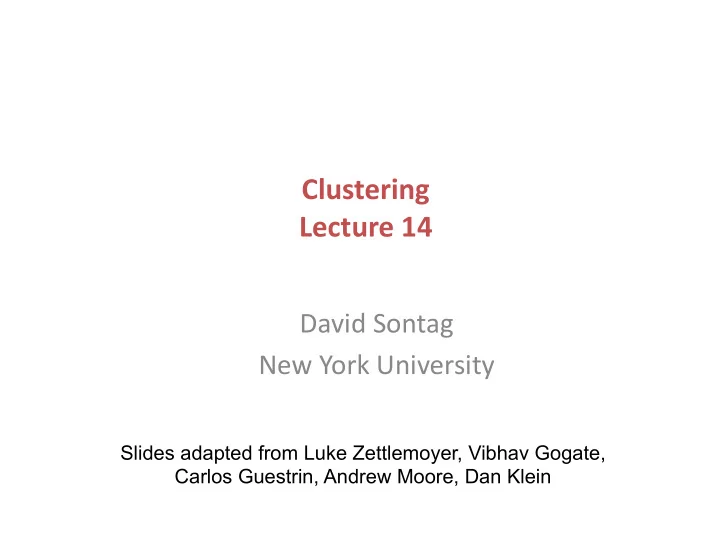

Clustering ¡ Lecture ¡14 ¡ David ¡Sontag ¡ New ¡York ¡University ¡ Slides adapted from Luke Zettlemoyer, Vibhav Gogate, Carlos Guestrin, Andrew Moore, Dan Klein
Clustering Clustering: – Unsupervised learning – Requires data, but no labels – Detect patterns e.g. in • Group emails or search results • Customer shopping patterns • Regions of images – Useful when don’t know what you’re looking for – But: can get gibberish
Clustering • Basic idea: group together similar instances • Example: 2D point patterns
Clustering • Basic idea: group together similar instances • Example: 2D point patterns
Clustering • Basic idea: group together similar instances • Example: 2D point patterns • What could “ similar ” mean? – One option: small Euclidean distance (squared) y || 2 dist( ~ x, ~ y ) = || ~ x − ~ 2 – Clustering results are crucially dependent on the measure of similarity (or distance) between “points” to be clustered
� � � � � � � � Clustering algorithms • 8+'%(%(,) � +"*,'(%-.$ � 9:"+%; – < � .&+)$ – =(>%#'& � ,? � @+#$$(+) – A2&0%'+" � !"#$%&'()* � • /(&'+'0-(0+" � +"*,'(%-.$ � – 1,%%,. � #2 � 3 +**",.&'+%(4& – 5,2 � 6,7) � 3 6(4($(4& � � � � � � �
Clustering examples ¡ Image ¡segmenta3on ¡ Goal: ¡Break ¡up ¡the ¡image ¡into ¡meaningful ¡or ¡ perceptually ¡similar ¡regions ¡ [Slide from James Hayes]
Clustering examples Clustering gene expression data Eisen et al, PNAS 1998
Clustering examples ¡ Cluster ¡news ¡ ar3cles ¡
Clustering examples Cluster ¡people ¡by ¡space ¡and ¡3me ¡ [Image from Pilho Kim]
Clustering examples Clustering ¡languages ¡ [Image from scienceinschool.org]
Clustering examples Clustering ¡languages ¡ [Image from dhushara.com]
Clustering examples Clustering ¡species ¡ (“phylogeny”) ¡ [Lindblad-Toh et al., Nature 2005]
Clustering examples Clustering ¡search ¡queries ¡
K-Means • An iterative clustering algorithm – Initialize: Pick K random points as cluster centers – Alternate: 1. Assign data points to closest cluster center 2. Change the cluster center to the average of its assigned points – Stop when no points ’ assignments change
K-Means • An iterative clustering algorithm – Initialize: Pick K random points as cluster centers – Alternate: 1. Assign data points to closest cluster center 2. Change the cluster center to the average of its assigned points – Stop when no points ’ assignments change
K-‑means ¡clustering: ¡Example ¡ • Pick K random points as cluster centers (means) Shown here for K =2 17
K-‑means ¡clustering: ¡Example ¡ Iterative Step 1 • Assign data points to closest cluster center 18
K-‑means ¡clustering: ¡Example ¡ Iterative Step 2 • Change the cluster center to the average of the assigned points 19
K-‑means ¡clustering: ¡Example ¡ • Repeat ¡unDl ¡ convergence ¡ 20
K-‑means ¡clustering: ¡Example ¡ 21
K-‑means ¡clustering: ¡Example ¡ 22
K-‑means ¡clustering: ¡Example ¡ 23
ProperDes ¡of ¡K-‑means ¡ algorithm ¡ • Guaranteed ¡to ¡converge ¡in ¡a ¡finite ¡number ¡of ¡ iteraDons ¡ • Running ¡Dme ¡per ¡iteraDon: ¡ 1. Assign data points to closest cluster center O(KN) time 2. Change the cluster center to the average of its assigned points O(N) ¡
!"#$%& '(%)#*+#%,# !"#$%&'($ � � � � � � � � � ��� � ��� ��� � ��� -. /01 � � 2 � (340"05# � !" !"#$ � % � &' � ()#*+, � � � � � � � � � � � ��� � ��� � � � � � � � � ��� ��� � � 6. /01 � !# � (340"05# � �� � � � � � � � � � ��� ��� � ��� – 7$8# � 3$*40$9 � :#*0)$40)# � (; � � � $%: �  � 4( � 5#*(2 � <# � =$)# � � � � �� � � � � !"#$ � - � &' � ()#*+, ��� � !"#$%& 4$8#& � $% � $94#*%$40%+ � (340"05$40(% � $33*($,=2 � #$,= � &4#3 � 0& � +>$*$%4##: � 4( � :#,*#$&# � 4=# � (?@#,40)# � A 4=>& � +>$*$%4##: � 4( � ,(%)#*+# [Slide from Alan Fern]
Example: K-Means for Segmentation K=2 Original Goal of Segmentation is Original image K = 2 K = 3 K = 10 to partition an image into regions each of which has reasonably homogenous visual appearance.
Example: K-Means for Segmentation K=2 K=3 K=10 Original Original image K = 2 K = 3 K = 10
Example: K-Means for Segmentation K=2 K=3 K=10 Original Original image K = 2 K = 3 K = 10
Example: Vector quantization FIGURE 14.9. Sir Ronald A. Fisher ( 1890 − 1962 ) was one of the founders of modern day statistics, to whom we owe maximum-likelihood, su ffi ciency, and many other fundamental concepts. The image on the left is a 1024 × 1024 grayscale image at 8 bits per pixel. The center image is the result of 2 × 2 block VQ, using 200 code vectors, with a compression rate of 1 . 9 bits/pixel. The right image uses only four code vectors, with a compression rate of 0 . 50 bits/pixel [Figure from Hastie et al. book]
Initialization • K-means algorithm is a heuristic – Requires initial means – It does matter what you pick! – What can go wrong? – Various schemes for preventing this kind of thing: variance-based split / merge, initialization heuristics
K-Means Getting Stuck A local optimum: Would be better to have one cluster here … and two clusters here
K-means not able to properly cluster Y X
Changing the features (distance function) can help R θ
Recommend
More recommend